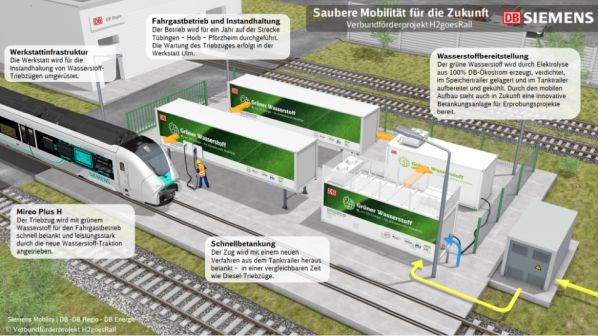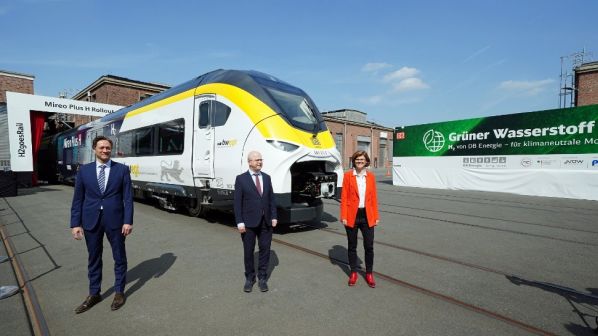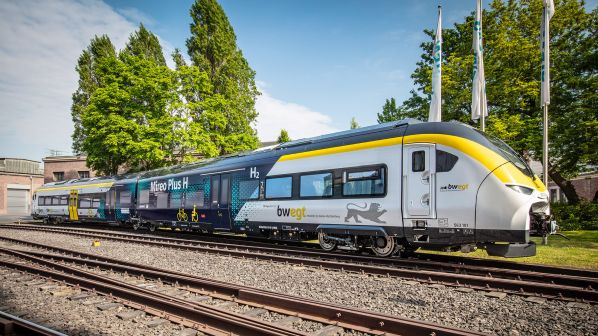GERMAN Rail (DB) and Siemens Mobility unveiled a new hydrogen train and mobile hydrogen storage trailer during an event at the manufacturer’s Krefeld plant on May 5.
The new 160km/h Mireo Plus H two-car hydrogen train has an operating range of up to 800km, while the three-car variant of the train has a range of 1000km. The propulsion system consists of a hydrogen fuel cell and lithium-ion battery. The manufacturer says that with a 1.7MW power rating, which can offer up to 1.1m/s² acceleration, the hydrogen train possesses similar performance to an equivalent EMU.
DB also presented a new mobile hydrogen refuelling concept and related maintenance strategy during the event, which DB’s board member for digitalisation and technology, Dr Daniela Gerd tom Markotten, says shows that “we can not only do mobility but technology as well.”
“Together with Siemens and the newly developed hydrogen train, we are creating an overall system which will take us another step towards phasing out diesel and enable the greening of the fleet,” she says.
The green hydrogen is produced by electrolysis at the DB maintenance depot in Tübingen using green electricity from the overhead line. Water is split into hydrogen and oxygen and after being compressed, the hydrogen is stored in a mobile storage unit, then processed and cooled prior to refuelling. The partners say the mobile system means it will be possible to conduct additional tests on non-electrified routes.
The partners add that the hydrogen refuelling concept offers performance equivalent to a diesel system, an essential development if hydrogen-powered rolling stock is to compete with diesel. “This is an especially important factor considering the closely timed scheduling of DB’s regional passenger service,” the two companies said in a statement. “The fast refuelling of hydrogen trains will make the technology competitive in daily operations.”

The train and refuelling concept have been developed under the H2goesRail project, funded under the German federal government’s National Innovation Programme for Hydrogen and Fuel Cell Technology (NIP 2). NIP 2 is co-ordinated by the National Organisation for Hydrogen and Fuel Cell Technology (NOW), with €13.74m of funding provided by the Federal Ministry for Digital and Transport (BMDV).
Mr Michael Theurer, parliamentary state secretary in the BMDV, says the project will support “virtually climate-neutral” operation on rail routes. “The H2goesRail project will not only test the use of hydrogen for rail, but substantially advance the technology,” he says.
DB and Siemens are set to begin testing the Mireo Plus H in Baden-Württemberg in 2023, ahead of entry into passenger service on the line between Tübingen, Horb and Pforzheim in 2024. The Mireo Plus H will replace a diesel train used on this route with approximately 120,000km of scheduled rail services planned.
The partners say the typical service frequency and topography of the route make it particularly suited to the tests. Replacing the diesel train is expected to save 330 tonnes of CO₂ every year. Drivers will be trained specifically to operate the hydrogen train in passenger service.
Siemens and DB will also showcase the H2goesRail project and the Mireo H Plus at InnoTrans in Berlin in September.
“With the Mireo Plus H, we’ve developed the next generation of hydrogen-powered trains that offers a particularly long operating range and faster acceleration,” says Mr Michael Peter, Siemens Mobility CEO. “Each delivered train can save up to 45,000 tons of CO2 over its service life of 30 years compared with corresponding travel with cars.”


